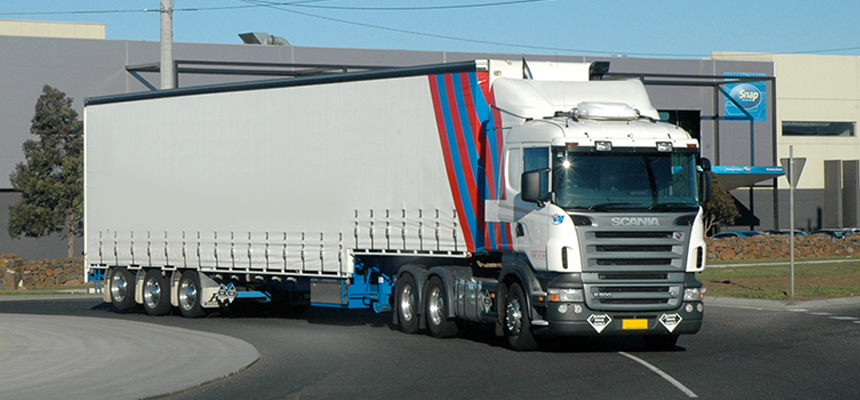The case for the PBS 20-metre semi-trailer
Around the world, the undisputed workhorse of the short-haul road freight system is the prime mover and semi-trailer. In Australia, our version of this key vehicle will typically be a 6×4 prime mover towing a tandem or triaxle semi-trailer, with a total length of no more than 19-metres. The combination is used for carrying all manner of goods ranging from parcels and dry freight to bulk liquids and grain.
The main benefits of the combination arise from two key strengths; being able to fit a reasonable amount of volume in the trailer and being able to get access to almost anywhere (known as General Access). Other longer and heavier combinations can carry more, but only have specific levels of access, and are more suited for long-haul applications. In contrast other 19-metre combinations like truck and dogs can get good access, but will be volume limited compared to the 19-meter semi-trailer.

With the Australian Performance Based Standards (PBS) scheme now passing a decade of implementation, we are seeing newer innovative combinations making in-roads daily, yet the conventional 19metre semi-trailer still sees widespread use. The key idea of PBS is to support combinations outside the normal regulation mass and dimension limits when the safety and productivity benefit is there. This kind of thinking should be applied to a 20metre version of the prime mover and semi-trailer.
By allowing a 20-metre combination widespread access some of the initial benefits include:
- Carrying an additional two to four pallets on each trip
- Carrying long intermodal containers
- Flexibility in choosing to use longer prime movers
- 10+ per cent increase in volume
- Increased fleet safety through meeting PBS requirements.
However, except for Queensland, jurisdictions have not been open to allowing General Access to 20metre combinations. Advantia has written about this previously but generally speaking, PBS Level 1 was created with the intention that it meet the same performance as General Access vehicles. As such, PBS Level 1 vehicles should in theory be eligible for General Access but this has not been forthcoming.
Instead in late 2018 a national notice was issued by the National Heavy Vehicle Regulator (NHVR) which did state that General Access was granted to PBS Level 1 vehicles, operating up to General Mass Limits. This cripples the use of 20-metre semi-trailer combinations because a key benefit of their use is being able to operate at Higher Mass Limits (HML) when on the correct routes. This gives the situation shown below when looking at General Access:
- 19m combinations, which are not operating under PBS, can load heavier
- 20m combinations, which are operating under PBS, must be loaded lighter.
This is totally at odds with what should be happening.
- Road managers have already allowed HML for 19-metre combinations. The loaded vehicle masses are not a problem.
- Road managers have already allowed General Access for 20-metre combinations. The 20metre overall length of the combination is not a problem.
- While it may seem counterintuitive, longer combinations generally perform better dynamically than shorter ones. The risks of longer combinations are instead generally observed through degraded low-speed swept path performance. However, by having the longer vehicles assessed under PBS, the performance is known to meet PBS Level 1 standards (which were based on General Access performance).
- Longer combinations also will generally have lower bridge loading impacts. By spreading out the axles farther than in the 19-metre combinations, most of the asset loading effects will be diminished. This means that a fleet of 20-metre semi-trailer will actually have a benefit on bridge loading compared to a fleet of 19-metre semi-trailer combinations.
- PBS vehicles have been shown to be consistently safer than other combinations due to being assessed, certified and held to a higher standard than prescriptive legal vehicles. PBS combinations should be given the same masses as currently legal prescriptive vehicles, if not more.
Thus, road managers already allow prime mover and semi-trailers to operate at HML and they already allow 20-metre combinations to get General access. They also limit the longer PBS combinations when they are safer, perform better dynamically, meet swept path requirements, and reduce infrastructure loading impacts.
Hence, replacing existing 19-metre semi-trailer combinations with 20-metre PBS counterparts at the same mass will not only be beneficial for infrastructure on a per-vehicle basis but will also reduce the number of vehicles on the road for a given freight task. Jurisdictions and road managers that do not allow 20-metre PBS prime mover and semi-trailers to get General Access at full HML weights are unnecessarily hindering the productivity and safety of the prime mover and semi-trailer fleet.
Get more like this in your inbox
Subscribe to our Newsletter and never miss a post.